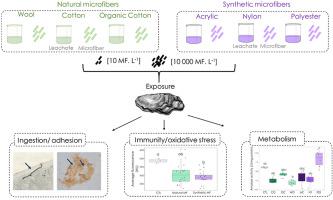Environmental Pollution ( IF 8.9 ) Pub Date : 2023-05-26 , DOI: 10.1016/j.envpol.2023.121861 Camille Détrée 1 , Clémentine Labbé 1 , Ika Paul-Pont 1 , Enora Prado 2 , Maria El Rakwe 2 , Lena Thomas 3 , Nicolas Delorme 4 , Nelly Le Goïc 1 , Arnaud Huvet 1

|
Fast fashion and our daily use of fibrous materials cause a massive release of microfibres (MF) into the oceans. Although MF pollution is commonly linked to plastics, the vast majority of collected MF are made from natural materials (e.g. cellulose). We investigated the effects of 96-h exposure to natural (wool, cotton, organic cotton) and synthetic (acrylic, nylon, polyester) textile MF and their associated chemical additives on the capacity of Pacific oysters Crassostrea gigas to ingest MF and the effects of MF and their leachates on key molecular and cellular endpoints. Digestive and glycolytic enzyme activities and immune and detoxification responses were determined at cellular (haemocyte viability, ROS production, ABC pump activity) and molecular (Ikb1, Ikb2, caspase 1 and EcSOD expression) levels, considering environmentally relevant (10 MF L−1) and worst-case scenarios (10 000 MF L−1). Ingestion of natural MF perturbed oyster digestive and immune functions, but synthetic MF had few effects, supposedly related with fibers weaving rather than the material itself. No concentration effects were found, suggesting that an environmental dose of MF is sufficient to trigger these responses. Leachate exposure had minimal effects on oyster physiology. These results suggest that the manufacture of the fibres and their characteristics could be the major factors of MF toxicity and stress the need to consider both natural and synthetic particles and their leachates to thoroughly evaluate the impact of anthropogenic debris.
Environmental Implication.
Microfibres (MF) are omnipresent in the world oceans with around 2 million tons released every year, resulting in their ingestion by a wide array of marine organisms. In the ocean, a domination of natural MF- representing more than 80% of collected fibres-over synthetic ones was observed. Despite MF pervasiveness, research on their impact on marine organisms, is still in its infancy. The current study aims to investigate the effects of environmental concentrations of both synthetic and natural textile MF and their associated leachates on a model filter feeder.
中文翻译:

进退两难:合成和天然纺织品超细纤维对太平洋牡蛎 Crassostrea gigas 生理学影响的评估
快时尚和我们日常使用的纤维材料导致大量微纤维 (MF) 释放到海洋中。虽然 MF 污染通常与塑料有关,但绝大多数收集的 MF 是由天然材料(例如纤维素)制成的。我们调查了 96 小时暴露于天然(羊毛、棉花、有机棉)和合成(腈纶、尼龙、聚酯)纺织品 MF 及其相关化学添加剂对太平洋牡蛎Crassostrea gigas能力的影响摄取 MF 以及 MF 及其渗滤液对关键分子和细胞终点的影响。消化和糖酵解酶活性以及免疫和解毒反应是在细胞(血细胞活力、ROS 产生、ABC 泵活性)和分子(Ikb1、Ikb2、半胱天冬酶 1 和 EcSOD 表达)水平上确定的,考虑到环境相关的 (10 MF L -1 )和最坏情况(10 000 MF L −1). 摄入天然 MF 会扰乱牡蛎的消化和免疫功能,但合成 MF 几乎没有影响,据推测与纤维编织有关,而不是材料本身。没有发现浓度效应,表明环境剂量的 MF 足以触发这些反应。渗滤液暴露对牡蛎生理学的影响很小。这些结果表明,纤维的制造及其特性可能是 MF 毒性的主要因素,并强调需要同时考虑天然和合成颗粒及其渗滤液,以彻底评估人为碎片的影响。
环境影响。
微纤维 (MF) 在世界海洋中无处不在,每年释放约 200 万吨,导致它们被各种海洋生物摄取。在海洋中,观察到天然 MF 占主导地位,占收集到的纤维超过合成纤维的 80%。尽管 MF 无处不在,但关于它们对海洋生物影响的研究仍处于起步阶段。目前的研究旨在调查合成和天然纺织品 MF 及其相关渗滤液的环境浓度对模型滤食器的影响。



























 京公网安备 11010802027423号
京公网安备 11010802027423号